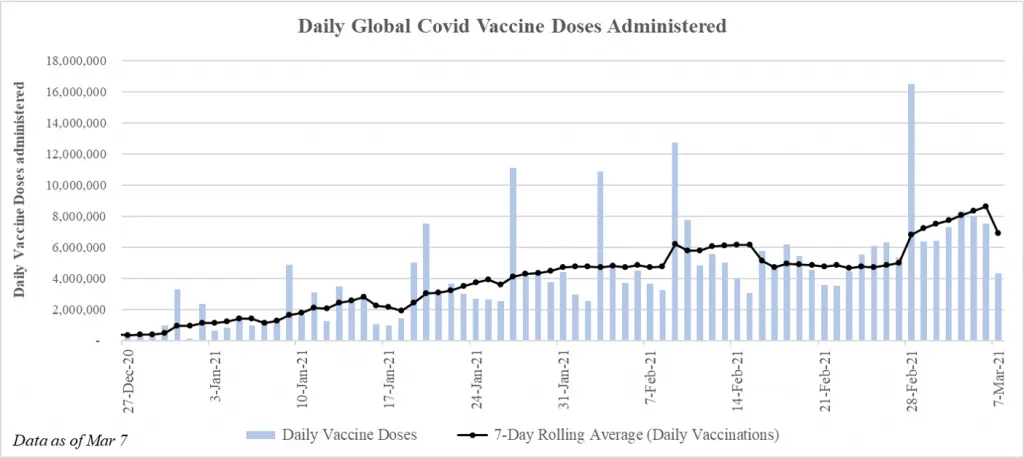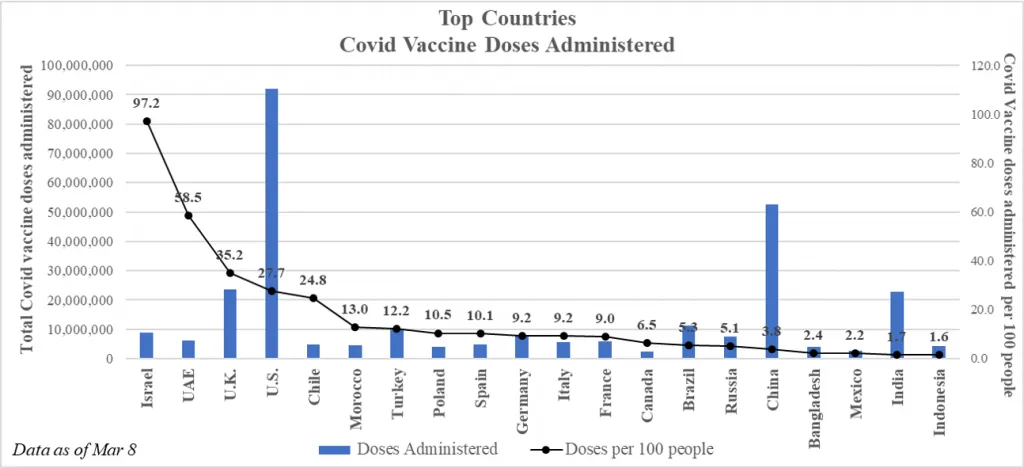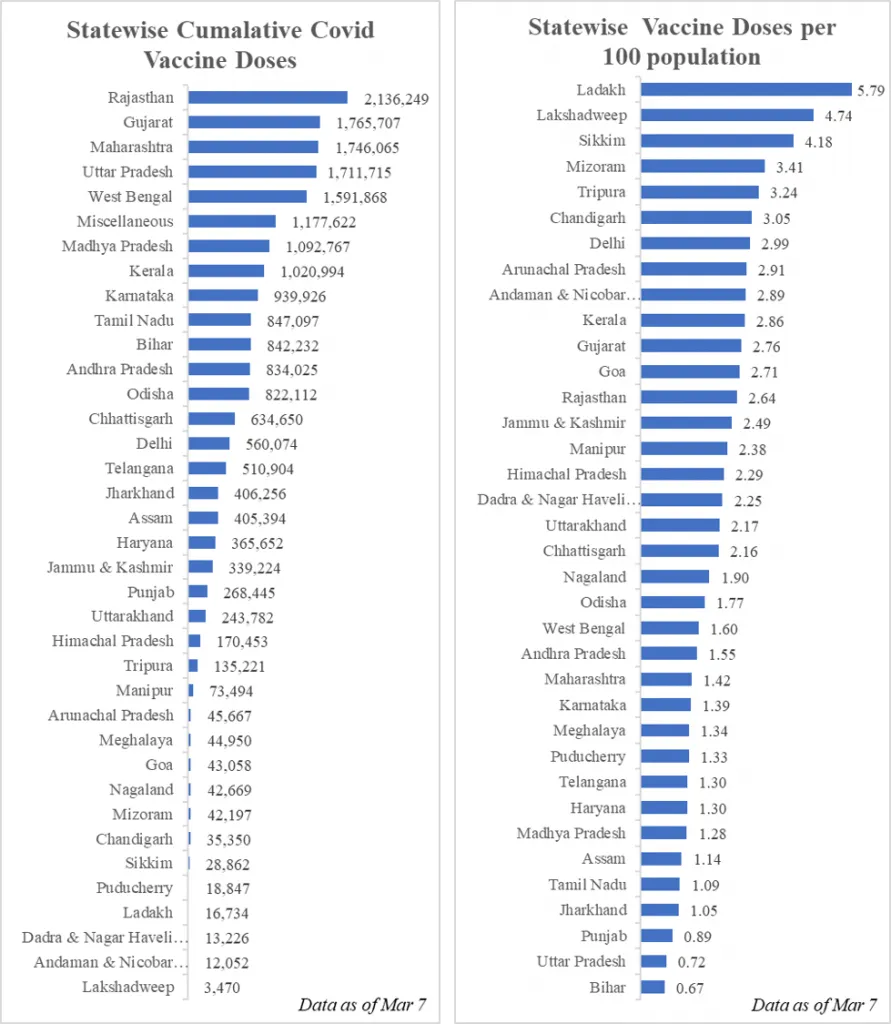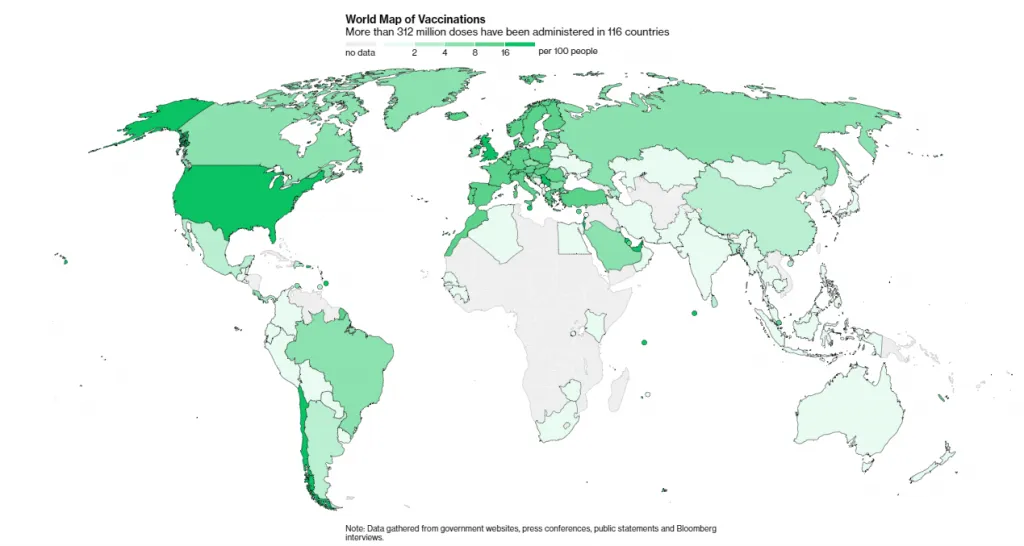 This is part of the weekly series assessing the COVID-19 vaccine rollout in India and the world.
This is part of the weekly series assessing the COVID-19 vaccine rollout in India and the world.
The COVID-19 vaccination campaign in the world is well underway, with more than
312 million doses administered across 116 countries. The average daily rate of inoculations is
8.08 million doses per day, approximately.
The past week, roughly 48 million COVID-19 inoculations were conducted in the world. The average daily rate of vaccinations witnessed a 20 percent rise during the last seven days — from 6.73 million to 8.08 million doses per day. At the current rate, the time needed to cover 75 percent of the global population with a two-dose vaccine is approximately
3.8 years. The coverage rate has almost halved in the past month, owing to the steady rise of inoculations per country and the number of countries inoculating.
As of 5 March, three new vaccine candidates have entered Phase 1 and one candidate has entered phase 2 of clinical trials, taking the total to
79 vaccines under clinical trials. Another 182 vaccine candidates are in the pre-clinical investigation stages. Currently,
21 vaccine candidates are in the final phases of testing in large-scale vaccine efficacy trials; however, only
six candidates have been approved for full use, namely, Pfizer-BioNTech, Moderna (both Pfizer and Moderna were fully approved in several countries, emergency use in the US, EU, other countries), Sinopharm (approved in China, the UAE, Bahrain), Sinovac (conditional approval in China), Sinopharm-Wuhan (limited use in China) and CanSino (approved in China). Other vaccine candidates from Oxford-AstraZeneca, Bharat Biotech and the newly added Johnson & Johnson vaccine continue to be used under emergency approvals.
Figure 1: Global COVID Vaccine Trend
 Author’s own, data source: Our World in Data
Author’s own, data source: Our World in Data
The COVID vaccine drive continues to be dominated by the United States, with 92 million doses administered, as of Mar 8, followed by China (52 million), the UK (23.5 million) and India (
23 million). While the USA and China lead in absolute doses administered, the countries seem to be lagging behind with 27.7 and 3.75 doses per 100 population, largely attributed to their high population base. Israel’s inoculation surpassed that of other countries with 97.1 doses administered for every 100 people.
Figure 2: Country wise COVID vaccine doses administered
 Author’s own, data source: Bloomberg Vaccine tracker
Author’s own, data source: Bloomberg Vaccine tracker
India’s COVID vaccine update
India’s total confirmed cases have surpassed
11.2 million, with 117,182 new cases reported in the past week. The past fortnight saw a 32 percent rise in cases, striking fear that the second wave of the country may have started.
Ninety seven COVID deaths were reported in the past 24 hours, taking the total to 157,890, as on 7 March.
India has administered
23 million doses, making it the fourth highest country in terms of total vaccine doses administered, with 1.53 doses administered per 100 people. In the past week, India conducted approximately 6.6 million inoculations, with an average of almost 1 million doses a day. India’s average daily vaccination rate more than doubled this week, reaching 955,392 (as on the week ending 7 March) from 454,916 (as on the week ending on 28 February). The inoculations per 100 population in India also rose by 46 percent in the last seven days.
After the initial lukewarm response, India’s daily inoculations observed a much-needed boost this week, following the vaccination of Indian PM Narendra Modi. Yesterday, a record of 2.01 million people were vaccinated. Additionally, the rising cases in the country — that have sparked second wave rumors — have further urged the citizens to vaccinate. Despite the initial mistrust over its controversial approval, Bharat Biotech’s recent update regarding the 81 percent efficacy of its vaccine on those without prior infection, may also have led to the surge in inoculations.
Figure 3: COVID Vaccine Trends in India
 Author’s own, data source: Ministry of Health and Family Welfare, Government of India
Author’s own, data source: Ministry of Health and Family Welfare, Government of India
Within India, Rajasthan has now taken the lead in COVID-19 inoculations, with 2.1 million shots, followed by Gujarat (1.76 million) and Maharashtra (1.74 million). Uttar Pradesh, the leader during the earlier weeks, has shifted to the fourth position with 1.71 million shots. In terms of doses per 100 population, Ladakh leads with 5.7 doses per 100 people, while the bigger states lag behind.
Bihar (0.67), Uttar Pradesh (0.72), and Punjab (0.89) are at the bottom of the inoculation list — each of these states is yet to vaccinate 1 in every 100 people. States such as Uttar Pradesh, Maharashtra, Bihar, Kerala and West Bengal, with a higher elderly population, require acute focus on their vaccination programme. These states also account for a higher case load, and therefore need to enhance the efficacy of the vaccination drive.
Figure 4: COVID Vaccine Trends in Indian States
 Author’s own, data source: Observer Research Foundation Vaccine Tracker
Author’s own, data source: Observer Research Foundation Vaccine Tracker
Last week, India
initiated the second phase of its vaccination drive to include people over 60 years of age and those of aged 45 and above with co-morbid conditions. As per the
Ministry of Health and Family Welfare, 4.3 million people over the age of 60 and more than 700,000 people between 45-60 years with co-morbidities have been vaccinated. This phase is expected to cover more than 130 million of the 60+ population alone, who constitute the majority of the vulnerable population.
In order attain the target of vaccinating a
quarter of its population by August, India needs to keep the momentum of the vaccination programme by opening the vaccination drive to younger Indians and ensuring demand-supply tailbacks of the programme are smoothly managed. While there is a hefty gap between the target and the achievement of it so far, stronger private sector engagement should enable India to reach a large population base faster. Additionally, multiple corporations have announced their support in vaccinating their employees.
#VaccineMaitri and way forward
Even though the number of countries that have initiated COVID-19 vaccination has increased steadily, access to vaccines remains partial to high- and upper middle-income countries.
At least 43 countries — mostly belonging to the North American and European region — have secured vaccine contracts to cover more than 110 percent of their population. The UK and Canada each have enough doses to cover three times their respective population. Conversely, many African countries are yet to initiate vaccination drives (Figure 5). Roughly,
16 percent of the world’s population has acquired 60 percent of the COVID vaccine doses. During the initial stages of the pandemic, vaccine makers had promised ‘
equitable access’ to the vaccines, but as of now, most contracts have been awarded to rich countries.
Figure 5: World Map of Vaccine Contracts
 Source: Bloomberg Vaccine tracker, as of 8 March 2021
Source: Bloomberg Vaccine tracker, as of 8 March 2021
Figure 6 shows the lack of equity in vaccine distribution globally. After more than three months of the ongoing vaccination campaign, very few lower-middle-income and low-income countries have started the vaccination drive. Even though the developing countries
constitute 71 percent of the priority population, only 53 developing countries have initiated the vaccination drive. Out of the 92 countries that have not started any vaccination till now, 81 are developing.
Figure 6: COVID Vaccine’s Inequitable Coverage
 Source: PandemIC Vaccine Equity Tracker, 8 March 2021
Source: PandemIC Vaccine Equity Tracker, 8 March 2021
Ignoring the vaccination of poorer economies could potentially lead to a loss of
US$ 9 trillion dollars to the global economy in 2021. Countries have been warned with regards to the economic consequences on vaccine inequity, however, much has not been done to eradicate the same.
Recently, the
US decided to block the export of key raw materials such as bags and hampers. Inadequate raw materials will be a critical limiting factor in the global supply of vaccines, one that may rescind the current efforts to eradicate the virus. Serum Institute of India CEO, Adar Poonawalla, quoted that the free global access to vaccines will be affected without timely access to raw materials from the US. Tackling the issues related to shortage of raw materials for different vaccine doses
will require a global export agreement for a smooth flow amongst countries.
Amidst uncertainty, India continues to aid the world, while also fighting the pandemic at home. With
57.8 million doses having been exported to countries across the world — including 6.3 million doses that were gifted to 13 countries — India aims to bridge the gap in vaccine inequality. This month, the Indian government authorised the commercial supply of
24 million vaccine doses to 25 countries. Last week,
Guyana, Jamaica and Nicaragua received their first consignments under the #VaccineMaitri Initiative. In the coming days,
49 countries in Europe, South Africa, Latin America, amongst others, will be supplied vaccines under this initiative. As India’s daily inoculations increase substantially, it is expected that the proportion between vaccine exports and domestic use is expected to shift from the current 3:1 to 2:1 in the short run and closer to 1:1 in the medium run.
The views expressed above belong to the author(s). ORF research and analyses now available on Telegram! Click here to access our curated content — blogs, longforms and interviews.



 This is part of the weekly series assessing the COVID-19 vaccine rollout in India and the world.
This is part of the weekly series assessing the COVID-19 vaccine rollout in India and the world.
 Author’s own, data source:
Author’s own, data source:  Author’s own, data source:
Author’s own, data source:  Author’s own, data source:
Author’s own, data source:  Author’s own, data source:
Author’s own, data source:  Source:
Source:  Source:
Source:  PREV
PREV


